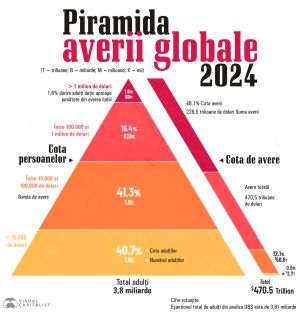The data published on Friday by the National Institute of Statistics show that almost a quarter (24.3%) of the population was affected by severe material and social deprivation, the number of poor people being at the end of last year 4,029,000 people, less by 278,000 people compared to the year 2021.
From the press release of the INS we note: "Estimated on the basis of total available income, excluding the consumption value from the household's own resources, the relative poverty rate (AROPE) was 21.2% in 2022, decreasing by 1.3 percentage points compared to the previous year. In absolute terms, the number of poor people was, in 2022, 4,029,000 people, 278,000 less than in 2021. The poverty rate by gender (21.7% for women and 20.8% for men male persons) highlights a decreasing trend of the difference between women and men, from 1.5 percentage points in 2021 to 0.9 percentage points in 2022".
According to INS experts, the highest incidence of poverty, 27%, is found among minors (people aged between 0 and 17), followed by young people between the ages of 18 and 24 where the poverty rate reaches 26.5 %. The poverty rate of people living in households with minors and youth aged 18-24 was 23.5% in 2022, 5.2 percentage points higher than that of people living in households without minors and youth.
INS also shows that social transfers play an important role in reducing the poverty rate. If pensions and other social transfers had not been paid in 2022, almost half of the population (45%) would have been below the relative poverty line and the situation would obviously have worsened for the elderly (65 years and over) who, in a proportion of 84.8%, would have been in a state of relative poverty. The same situation would have been recorded for people in the 55-64 age group, but in a lower proportion, 51.5%.
INS specialists also show that the acute lack of financial resources means that some people cannot afford to own some goods, make some payments or consume some products which, at the current stage of economic and social development, represent a minimum of elements necessary for a decent life . Thus, in 2022, the rate of severe material and social deprivation was 24.3%, increasing by 1.2 percentage points, compared to the previous year. The total number of people affected by severe material and social deprivation in 2022 was 4,594,000 people, of which 46.8% were men and 53.2% were women.
Severe material and social deprivation affects the population with varying intensity depending on age group and household income. In 2022, the incidence of severe material and social deprivation is higher mainly among people aged up to 18 years (30.8%) and among elderly people aged 65 and over (25.8%).
The INS data mentions that in 2022, among people aged up to 65, 597,000 were in households with very low work intensity (households in which adult people of working age carried out activities that required more less than 20% of their work potential). Compared to the previous year, the number of people in households with very low work intensity decreased by 105,000 people.
Moreover, the rate of risk of poverty or social exclusion (AROPE) was 34.4%, in 2022, corresponding to a number of 6.5 million people. The rate of risk of poverty or social exclusion affects women more than men (35.9% of women and 32.8% of men). INS specifies that age plays an important role, the AROPE indicator being, in 2022, higher for people aged 0-17 (41.5%) and for young people aged 18-24 (39.4%) and more low among people aged 25 - 49 (28.4%). The share of people aged 65 and over who were at risk of poverty or social exclusion was 37.2%.
In 2022, of all employed persons aged 18 and over, 23.7% were at risk of poverty or social exclusion, compared to 42.5% of all unemployed persons in the same age category. People who lived in households without dependent minors and 18-24-year-olds have a lower risk of poverty or social exclusion (32.2%), compared to people who lived in households with dependent minors and 18-24-year-olds (36%).
The highest incidence of the AROPE indicator, in 2022, was recorded in households consisting of two adults with three or more dependent children (60.8%), followed by that of single-parent households, with an incidence of 47.3%. In the case of households without minors and young people aged 18-24 dependents, the highest incidence was found among single-person households (43.6%), compared to 27.5% for households with two or more adults.
From the information presented by the INS, we also note that the risk of poverty or social exclusion is unevenly distributed regionally as well. The highest rate of risk of poverty or social exclusion was recorded in the South-East region (46.9%), closely followed by the South-West Oltenia region (44.7%), and the lowest rate was observed in the Bucharest region -Ilfov (19.2%).



























































